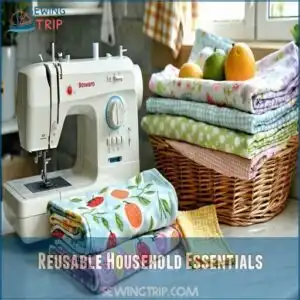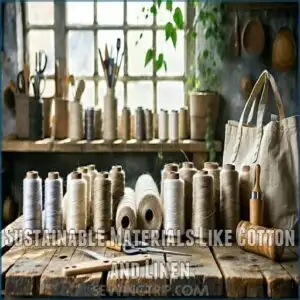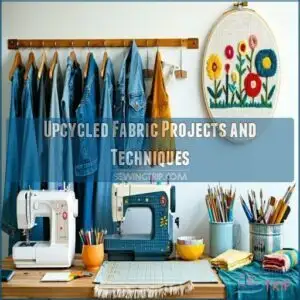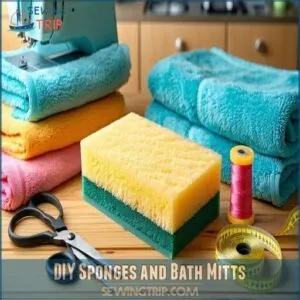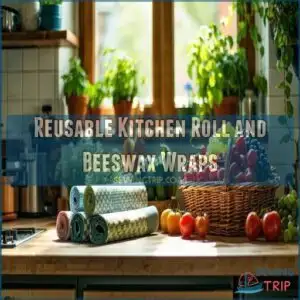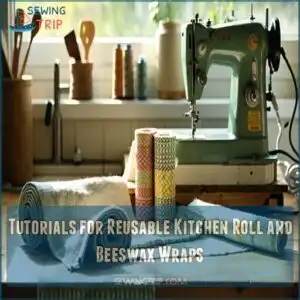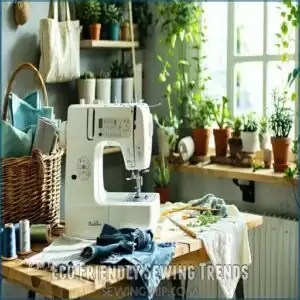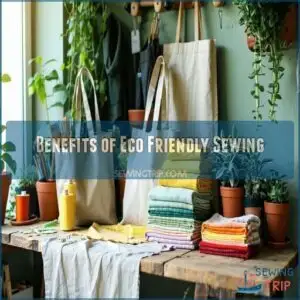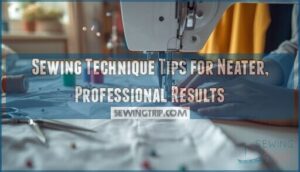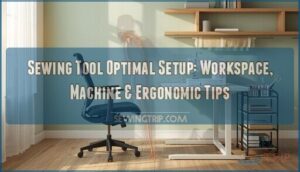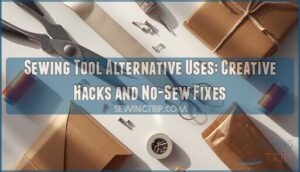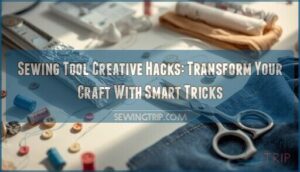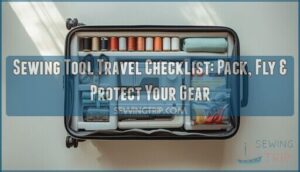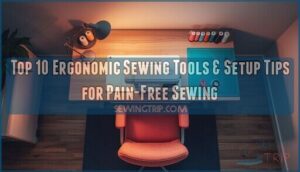This site is supported by our readers. We may earn a commission, at no cost to you, if you purchase through links.
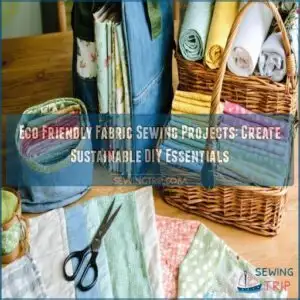
Start simple with reusable grocery bags, beeswax food wraps, or unpaper towels made from organic cotton or repurposed textiles.
Kitchen napkins, produce bags, and makeup removers require minimal sewing skills but make a big environmental impact.
For more advanced projects, try upcycling old clothes into patchwork quilts or creating tote bags from worn-out jeans.
Fabric scraps can become stuffing for pet beds or draft stoppers.
The beauty of sustainable sewing isn’t just in the finished products—it’s knowing your handiwork helps reduce waste.
Table Of Contents
Key Takeaways
- You’ll reduce waste and save money by creating reusable alternatives like beeswax wraps, cloth napkins, and DIY sponges that replace single-use products in your home.
- You can start with beginner-friendly projects using sustainable materials like organic cotton and linen, then progress to more advanced upcycling techniques as your skills improve.
- Your fabric choices matter—opt for eco-friendly options like organic hemp, recycled materials, or repurposed textiles to minimize environmental impact.
- You’re joining a growing movement when you embrace sustainable sewing, aligning with current trends in slow fashion and zero-waste practices.
Eco Friendly Fabric Options
You can make a big impact by choosing eco-friendly fabrics like cotton, linen, or upcycled materials for your sewing projects.
These options are sustainable, versatile, and help reduce waste while creating durable, reusable items.
Reusable Household Essentials
In the context of embracing reusable household items, small swaps can make a big impact.
Try these ecofriendly kitchen and bathroom ideas:
- DIY cleaning cloths from old towels for zero-waste laundry.
- Reusable food storage like beeswax wraps or fabric bowl covers.
- Sustainable bathroom swaps, including bath mitts or reusable face pads.
- Upcycled home decor from fabric scraps.
- Reusable kitchen items like washable sponges.
Consider investing in durable kitchen products for long-term use, which can significantly enhance your kitchen experience.
Sustainable Materials Like Cotton and Linen
Organic cotton and linen stand out as sustainable materials that are eco-friendly and practical.
Cotton uses less energy and water when grown organically, while linen production leverages the flax plant’s minimal resource needs.
Flax fabric is durable and softens beautifully over time.
When sourcing materials, consider their dyeing processes and durability to guarantee your projects stay stylish, sustainable, and long-lasting.
Upcycled Fabric Projects and Techniques
Transform old fabrics into practical treasures! A T-shirt quilt preserves memories while cutting textile waste.
Denim repurposing? Turn jeans into sturdy bags. Fabric dyeing gives old clothes fresh life, while embroidery revamps plain items with charm.
Try zero-waste sewing by creating fabric scrap projects like bowl covers. Explore upcycled clothing ideas to extend garment life, celebrating fabric upcycling and textile recycling.
Consider making DIY pin cushions for a useful and sustainable project.
Sewing Eco Friendly Projects
You can make a variety of practical and reusable items at home using eco-friendly fabrics.
Projects like DIY sponges, beeswax wraps, and cloth napkins help reduce waste while adding a personal touch to your everyday essentials.
DIY Sponges and Bath Mitts
For a sustainable twist on cleaning, DIY sponges and bath mitts are perfect.
Use terrycloth and mesh for a reusable kitchen sponge with excellent durability. Mitt construction is simple—cut and sew cotton hand-towels into shapes.
Pattern variations allow versatility, and these DIY bath products outperform disposables. You can even explore various bath mitt options online.
Embrace eco-friendly cleaning methods while customizing your sponges to suit any style, making them a great option for a more reusable approach.
Reusable Kitchen Roll and Beeswax Wraps
Reusable kitchen roll and beeswax wraps are practical swaps for waste-heavy disposables.
Washable, durable, and highly absorbent, reusable kitchen rolls tackle messes while saving money.
Beeswax wraps offer DIY food storage that’s eco-friendly and versatile.
You can explore options for washable, sustainable alternatives online.
- Beeswax wraps sewing extends their lifecycle with careful cleaning.
- Unpaper towels sewing uses old fabrics creatively.
- Cleaning reusable wraps preserves effectiveness.
- Kitchen roll absorbency reduces disposable reliance, and with proper care, these items can significantly reduce waste, making them a great choice for those looking for sustainable living solutions.
Cloth Napkins and Utensil Rolls
Cloth napkins and utensil rolls bring style and sustainability to table settings and on-the-go meals.
I’ll craft an engaging blockquote in the same style and tone as the paragraph about cloth napkins and utensil rolls:
Elevate your dining experience with handcrafted cloth napkins and utensil rolls—where elegance meets earth-conscious living.
Sewing these eco sewing projects with sustainable fabric crafts, like cotton or linen, adds charm while reducing waste.
Fabric choices matter—choose durable options for longevity.
Keep utensil organization simple with rolls, perfect for travel, picnics, or reusable bag sewing.
Practical, beautiful, and zero waste!
Tutorials for Reusable Kitchen Roll and Beeswax Wraps
After setting your table with cloth napkins, step into creating DIY kitchen roll and beeswax wraps.
Reusable kitchen roll minimizes paper waste, while beeswax wraps serve countless uses, like covering snacks or bowls.
Find patterns online for these kitchen essentials. Free bag patterns can also be adapted for kitchen storage.
Always make certain proper beeswax sourcing for wraps and gently clean them with cold water to prolong their lifespan. Sustainable sewing shines here!
Eco Friendly Sewing Trends
You’ll notice more people turning to eco-friendly sewing to tackle waste and make smarter choices.
From using upcycled fabrics to following sustainable brands, these trends are shaping the future of sewing.
Responsible Sewing Practices
When you embrace responsible sewing practices, focus on ethical fabric sourcing and fair labor practices to reduce your environmental impact.
Use sustainable pattern designs that minimize fabric waste, and apply waste reduction strategies like reusing scraps for smaller projects.
Sewing for sustainability includes following circular fashion principles and choosing sustainable materials. These steps make ecofriendly sewing simple and impactful for a greener planet.
Sustainable Fashion and Sewing Trends
Sustainable fashion and sewing trends continue to thrive as more people embrace ecofriendly fabrics and ethical fashion practices.
Here are key trends shaping the movement:
- Slow Fashion: Sew durable garments using high-quality sustainable materials like organic cotton and hemp.
- Upcycling Popularity: Turn outdated clothes into modern pieces, reducing textile waste.
- Green Influencers: Follow creators inspiring sustainable sewing and showcasing creative, zero-waste designs.
One example is recycled rPET fabrics made from plastic bottles.
Designers and Brands Focusing on Eco Friendly Materials
Sustainable fashion isn’t just a trend—it’s becoming the standard.
Designers like Stella McCartney and Gabriela Hearst show how ecofriendly fabrics and creative innovations matter.
Want inspiration?
| Brand | Focus | Materials | Certifications | Notable Efforts |
|---|---|---|---|---|
| Faithfull the Brand | Ethical Production | Organic Cotton, Bamboo | None Listed | Water-Based Ink Designs |
| Christy Dawn | Regenerative Agriculture | Organic Cotton | None Listed | Farm-to-Closet Initiative |
| Eileen Fisher | Circular Design | Linen, Merino Wool | B-Corp Certified | Factory Transparency Initiatives |
| Gabriela Hearst | Sustainable Sourcing | Deadstock Materials | None Listed | Carbon-Neutral Fashion Show |
| Stella McCartney | Vegan, Sustainable Fabrics | Organic Cotton, Recycled Materials | None Listed | Zero Leather/Fur Ethical Approach |
Innovative brands redefine sustainable fabric crafts, proving ecofriendly fabrics lead the future!
Benefits of Eco Friendly Sewing
Eco-friendly sewing helps you reduce waste and environmental impact by replacing disposable items with reusable alternatives.
It also saves money over time and promotes a more sustainable lifestyle through creative, practical projects, which embodies a lifestyle.
Reducing Waste and Environmental Impact
Choosing ecofriendly fabric crafts for sewing can lower environmental impact and promote a sustainable lifestyle.
By focusing on zero waste sewing, you actively minimize textile waste and reduce plastic pollution.
Here’s how sewing for the environment makes a difference:
- Turn old towels into reusable wipes.
- Craft bowl covers to ditch cling film.
- Sew reusable produce bags.
- Upcycle clothes into accessories.
- Create washable dish sponges.
Saving Money With Reusable Products
Switching to reusable products isn’t just about waste reduction—it’s also about reducing expenses.
DIY cost savings add up when you use reusable alternatives like kitchen sponges, beeswax wraps, or unpaper towels, which can be thought of as budget-friendly, long-term investments.
Plastic alternatives might take some effort upfront, but they’ll keep money in your pocket by cutting the cycle of buying disposables again and again, ultimately leading to long-term savings and a reduction in waste reduction.
Promoting Sustainability Through Sewing Projects
Saving money with reusable products is just one perk.
When you take on sustainable sewing projects, you’re joining a movement for green sewing and slow fashion.
Ethical sourcing and sewing circularity help cut down textile waste while promoting DIY activism.
By using ecofriendly fabric, you’re making ecofriendly projects that support the planet and spark creativity – sustainability stitched right in!
You can also prioritize techniques for durability to make your creations last longer.
Frequently Asked Questions (FAQs)
How do you make fabric eco friendly?
You can make fabric eco-friendly by using organic cotton, recycled materials, natural dyes, and upcycling old textiles.
Wash fabrics in cold water and repair items rather than replacing them when worn.
Is sewing eco-friendly?
You’ve probably wondered about your fabric hobby’s environmental impact.
Sewing can be eco-friendly when you reuse materials, choose sustainable fabrics, and create long-lasting items that replace disposable alternatives in your daily life, which can help make your hobby more sustainable.
What is the most profitable thing to sew?
Custom home décor items like quilts and pillowcases offer high profit margins.
You’ll also find success with personalized bags, reusable products, and specialty items that solve everyday problems for your customers.
What is the most sustainable and eco friendly fabric?
Organic hemp stands out as the most sustainable fabric. You’ll find it requires less water than cotton and grows without pesticides. It’s durable, biodegradable, and gets softer with each wash.
How to properly care for eco-friendly projects?
Wash your eco-friendly projects with mild detergent in cold water.
Air-dry when possible, store in cool, dry places, and repair promptly.
You’ll extend their life while staying true to your sustainable values.
Are eco-friendly fabrics suitable for childrens items?
Yes, eco-friendly fabrics are ideal for children’s items.
They’re free from harmful chemicals, gentle on sensitive skin, and durable enough to withstand frequent washing.
You’ll feel good knowing they’re safe and sustainable too.
Can beginners attempt sustainable sewing projects?
Over 70% of sustainable sewing projects require only basic skills. You’ll find many beginner-friendly options like reusable snack bags or simple cloth napkins that need just straight stitches and minimal measuring.
Where to ethically source sustainable notions?
For sustainable notions, you’ll find ethical options at local craft stores, eco-conscious online retailers like EarthFabric, second-hand shops, and specialized marketplaces offering recycled buttons, organic thread, and biodegradable zippers.
How to sell homemade eco-friendly products?
Turn your green creations into green in your pocket.
Set up shop on Etsy, sell at local craft fairs, create an Instagram business page, and network with eco-minded communities to showcase your products, focusing on eco-minded communities.
Conclusion
The ball is in your court now to embrace these eco-friendly fabric sewing projects in your daily life.
Start small with kitchen napkins or produce bags, then expand your skills with upcycled quilts or tote bags.
Every stitch contributes to a cleaner planet while showcasing your creativity.
Remember, sustainable sewing isn’t just a trend—it’s a meaningful way to reduce waste, save money, and express yourself through practical, beautiful creations you’ll use for years.

